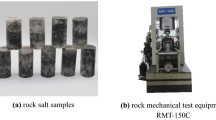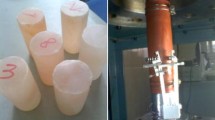Summary
The paper deals with uniaxial relaxation tests on rock salt which are the basis for a constitutive equation. Since so far no regard was paid to relaxation behaviour, corresponding test results are not available and hence a special device for performing of uniaxial relaxation tests had to be constructed. Some interesting test results are discussed in the paper. These results are useful for the verification of constitutive equations. A critical analysis of conventional constitutive laws and their fundamentals shows that these material laws have considerable imperfections and are rested on substantial restrictions. Particularly, they are not able to describe relaxation behaviour sufficiently. Consequently, a constitutive law is proposed consisting of a strain hardening approach with separate creep and relaxation functions. By post-calculation of different laboratory tests it could be shown that in comparison to conventional steady-state creep equations this material law describes the viscous behaviour of rock salt more realistically.
Similar content being viewed by others
References
Albrecht, H., Hunsche, U. (1980): Gebirgsmechanische Aspekte bei der Endlagerung radioaktiver Abfälle in Salzdiapiren unter besonderer Berücksichtigung des Fließverhaltens von Steinsalz. Fortschr. Miner. 58, 212–247.
Balthasar, K., Haupt. M., Lempp, C., Natau, O. (1987): Stress relaxation behaviour of rock salt: Comparison of in situ measurements and laboratory test results. Proc. 6th Int. Congr. Rock Mech., Montreal.
Becker, E., Bürger, W. (1975). Kontinuumsmechanik. B. G. Teubner, Stuttgart.
Cernocky, E. P., Krempl, E. (1979): A non-linear uniaxial integral constitutive equation incorporating rate effects, creep and relaxation. Int. J. Nonlinear Mech. 14, 183–203.
Cernocky, E. P., Krempl, E. (1980): A theory of viscoplasticity based on infinitesimal total strain. Acta Mechanica 36, 263–289.
Dreyer, W. (1967): Die Festigkeitseigenschaften natürlicher Gesteine insbesondere der Salz- und Karbongesteine. Clausthaler Hefte zur Lagerstättenkunde und Geochemie der mineralischen Rohstoffe 5.
Fernandez, G., Hendron, A. J. (1984): Interpretation of a long-term in situ borehole test in a deep salt formation. Bull. of the Ass. of Eng. Geol. 21, 23–38.
Frost, H. J., Ashby, M. F. (1984). Deformation-mechanism maps. Pergamon Press, Oxford.
Haupt, M. (1988): Entwicklung eines Stoffgesetzes für Steinsalz auf der Basis von Kriech- und Relaxationsversuchen. Veröff. Inst. für Bodenmech. und Felsmech. der Universität Karlsruhe.
Heard, H. C. (1972): Steady-state flow in polycrystalline halite at pressure of 2 kilobars. Flow and Fracture of Rocks, Am. Geophys. Union, 191–209.
Höfer, K.-H., Knoll, P. (1971): Investigations into the mechanism of creep deformation in carnallitite and practical applications. Int. J. Rock Mech. Min. Sci. 8, 61–73.
Le Comte, P. (1965): Creep in rock salt. J. of Geology 73, 469–484.
Liu, M. C. M., Krempl, E. (1979): A uniaxial viscoplastic model based on total strain and overstress. J. Mech. Phys. Solids 27 377–391.
Lomenick, T. F., Bradshaw, R. L. (1969): Deformation of rock salt in openings mined for the disposal of radioactive wastes. Rock Mechanics 1 (1), 5–29.
McCartney, L. N. (1976): No time — gentlemen please! Philos. Mag. 33, 689–695.
McVetty, P. G. (1943): Creep of metals at elevated temperatures — the hyperbolicsine relation between stress and creep rate. Transactions of the A. S. M. E., 761–769.
Menzel, W., Schreiner, W. (1975): Das Festigkeits- und Verformungsverhalten von Carnallitit als Grundlage für die Standsicherheitsbewertung von Grubenbauten. Neue Bergbautechnik 5, 451–457.
Menzel, W., Schreiner, W. (1977): Zum geomechanischen Verhalten von Steinsalz verschiedener Lagerstätten der DDR. Teil II: Das Verformungsverhalten. Neue Bergbautechnik 7, 565–574.
Mott, N. F. (1953): A theory of work-hardening of metals — II: Flow without sliplines, recovery and creep. Philos. Mag. 44, 742–765.
Munson, D. E., Dawson, P.R. (1984): Salt constitutive modeling using mechanism maps. First Conf. Mech. Beh. of Salt, Pennsylvania State University, University Park.
Nadai, A. (1938): The influence of time upon creep, the hyperbolic sine creep law. Timoshenko Anniversary Volume, Macmillan, New York, 155–170.
Nicolas, A., Poirier, J. P. (1976). Crystalline plasticity and solid flow in metamorphic rocks. J. Wiley, New York.
Odqvist, F. K. G., Hult, J. (1962): Kriechfestigkeit metallischer Werkstoffe. Springer, Berlin Göttingen Heidelberg.
Poirier, J. P. (1985). Creep of crystals. Cambridge University Press, Cambridge.
Prandtl, L. (1928): Ein Gedankenmodell zur kinematischen Theorie der festen Körper. Zeitschr. f. angew. Mathem. u. Mechanik 8, 85–106.
Reiner, M. (1968): Rheologie in elementarer Darstellung. Carl Hanser Verlag, München.
Rivlin, R. S. (1970): Red herrings and sundry unidentified fish in non-linear continuum mechanics. Inelastic behaviour of solids. McGraw-Hill, New York.
Serata, S. (1968): Application of continuum mechanics to design of deep potash mines in Canada. Int. J. Rock Mech. Min. Sci. 5, 293–314.
Thoms, R. L., Char, C. V., Bergeron, W. J. (1973): Finite element analysis of rock-salt pillar models. Proc. 14th Symp. Rock Mech., Pennsylvania, 392–408.
Verrall, R. A., Fields, R. J., Ashby, M. F. (1977): Deformation-mechanism maps for LiF and NaCl. J. of the Am. Ceramic Soc. 60, 211–216.
Wagner, R. A. (1982): An evaluation of a finite element simulation of the thermomechanical response of dome salt to an emplaced heat source. Int. Symp. Num. Models in Geomech., Zurich, 499–507.
Wawersik, W. R. (1985): Determination of steady state creep rates and activation parameters for rock salt. Spec. Techn. Publ. 869, Am. Soc. for Testing and Materials, Philadelphia.
Wawersik, W. R., Herrmann, W., Montgomery, S. T., Lauson, H. S. (1984): Excavation design in rock salt — laboratory experiments, material modeling and validations. Proc. ISRM-Symp. Aachen, 1345–1356.
Winkel, B. V., Gerstle, K. H., Ko, H. Y. (1972): Analysis of time-dependent deformations of openings in salt media. Int. J. Rock Mech. Min. Sci. 9, 249–260.
Author information
Authors and Affiliations
Rights and permissions
About this article
Cite this article
Haupt, M. A constitutive law for rock salt based on creep and relaxation tests. Rock Mech Rock Engng 24, 179–206 (1991). https://doi.org/10.1007/BF01045031
Issue Date:
DOI: https://doi.org/10.1007/BF01045031




